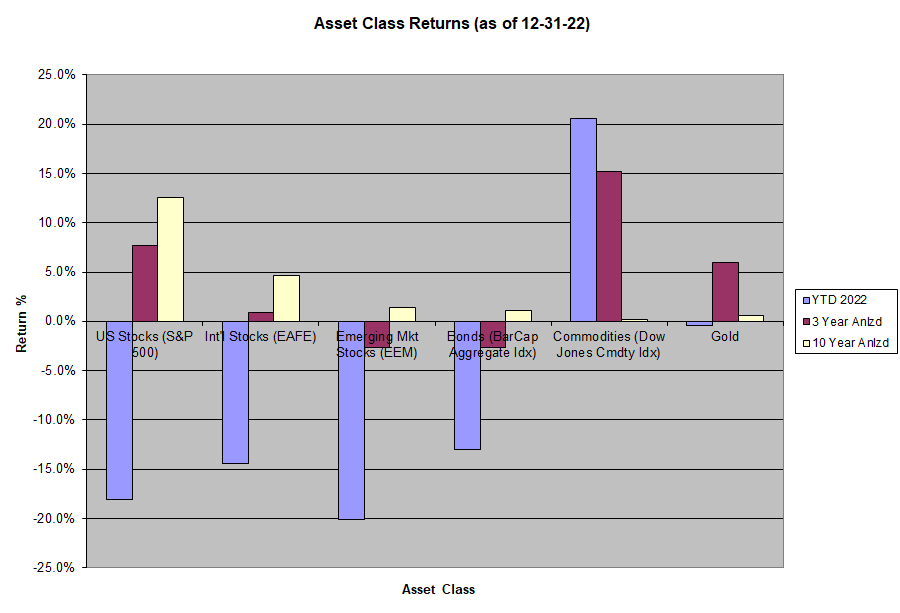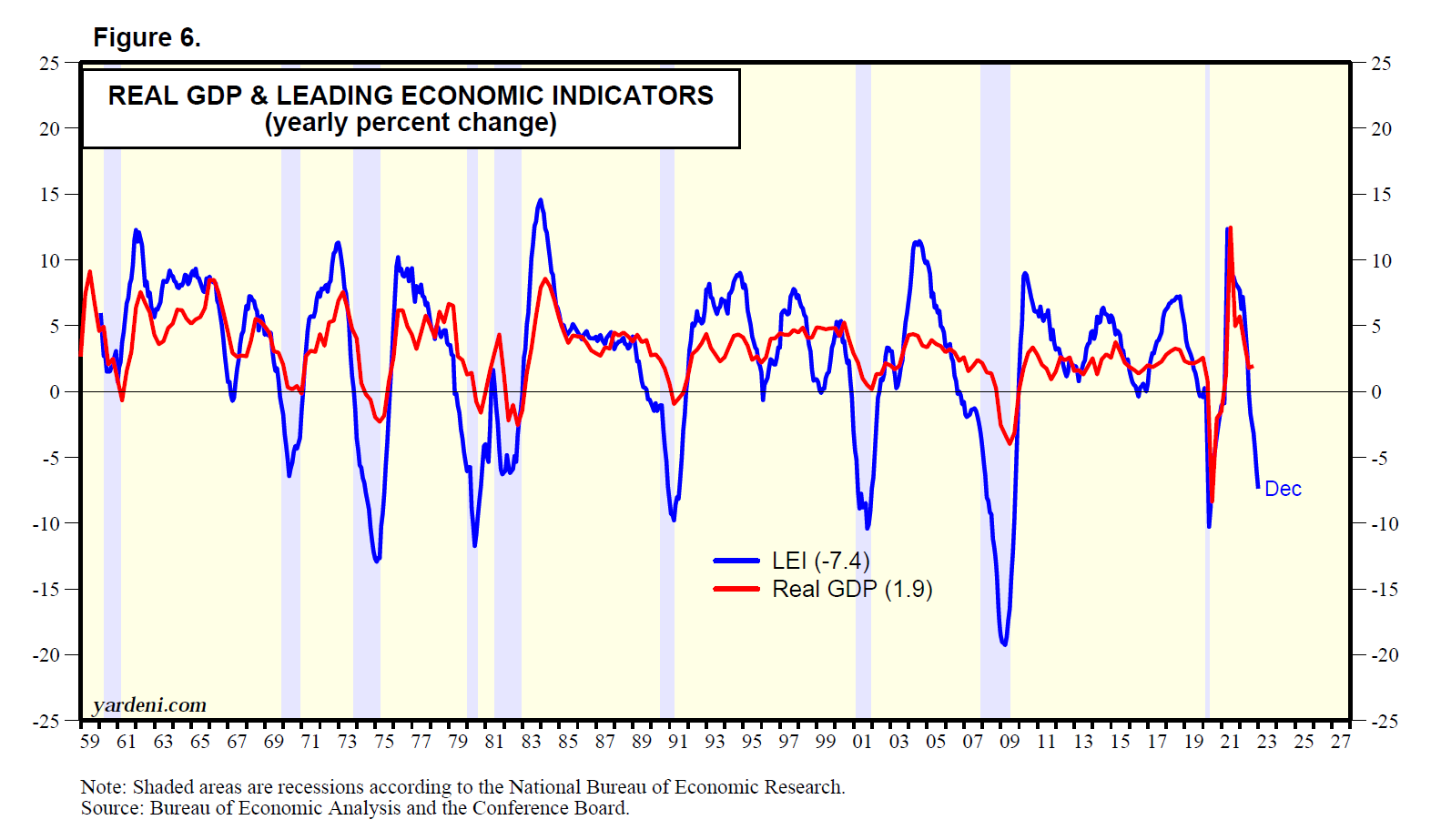Portfolio Resilience
2022 marked a negative year for markets, as inflation, rising interest rates, and geopolitical strife weighed on stocks, bonds, housing, and just about every global asset market. A few of the questions looming in investors’ minds for 2023 include: will inflation continue to abate? Will the federal reserve bank pause their interest rate hiking regime soon? Will the US economy spiral in to a deep recession? Did the bear market in stocks find a bottom on October 12th, or will there be another leg lower? Will the war in Ukraine come to a conclusion? We ask an even broader question. For long-term investors, will any of this really matter?
Our answer to the last question is no, it’s unlikely that the unfolding economic, political and market environment of 2023 will have a long-lasting impact for long-term investors. This is not to be cavalier or in any way dismissive of risk (see our 2023 outlook below for more on our current views). But our views, like everyone’s, are also baked with biases, missing information, and uncertainty. You should run, not walk, quickly from anyone who says they can consistently predict the direction of the stock market or economy.
Macro Matters. But Less than You Think
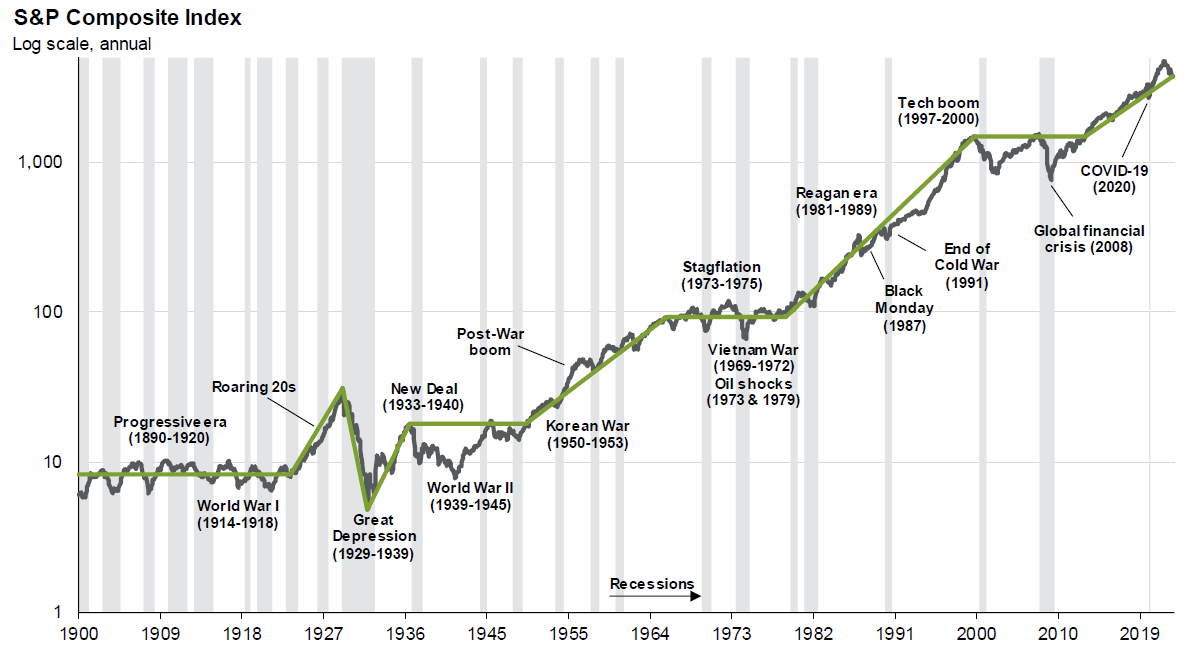
Source: Fact Set, NBER, Robert Shiller, J.P. Morgan Asset Management
The reason we feel confident that the risks of 2023 will not significantly impact long-term portfolio success is that we have been here before. The “this time is different mantra” just isn’t consistent with historical reality. We’ve highlighted in past letters Economist Ed Yardeni’s list of market “panic attacks”. Through 2022 Yardeni counts 70 panic attacks that have roiled markets in just the last 14 years. Based on these numbers, one might venture to say that the very history of markets is a never-ending series of panic attacks. Some result in major draw downs, but the vast majority fizzle out before they get started.
We all remember the great financial crisis and the Covid19 market sell-offs. But how many remember the near 20% market decline that ensued following Fed Chairman Powell’s hawkish interview in 2018 (barely 3 short years ago)? What about the mini-emerging markets crisis from 2014? Surely we all remember the Greek Debt crisis from 2011-2012, but what about the Chinese Slowdown fears of 2010?
Most of these macro related panic attacks are out of your control. What is in your control is what to do when faced with uncertainty and seemingly endless danger. There is a siren song calling investors to take action, to try to be smarter than the person on the other side of the trade, to side-step volatility but get back in just in time for the upside. But we view this as a mirage. Markets are highly complex and dynamic, and if you are taking action based on the news of the day, then you may be too late.
None of this is to suggest that global-macro risks don’t matter. These risks can and will move asset prices in the short-run, and for investors lacking a well-conceived and resilient portfolio strategy, they could result in significant longer-term portfolio damage. This risk of portfolio damage comes not from the downturn itself, but from how you react to it. The future encompasses nearly infinite potential outcomes, and often, in our experience, the outcome that seems most likely does not come to pass. Instead of making portfolio decisions based on predictions of the unknowable future, we feel that it is better to focus on the construction of resilient portfolios that can weather a variety of outcomes.
Building Blocks of a Resilient Portfolio
Diversification
The timeless advice to “not put all of your eggs in one basket” should not be discounted or underestimated. Often investors think they are diversified because they own “many mutual funds”, or “lots of stocks”. But real investment diversification is about more than the number of investments held. Simply put a portfolio of 100 technology stocks is not, in our view, diversified or resilient. A major technology downturn would make this portfolio much more susceptible to steep losses. This may sound obvious, but this is a real world example from the technology bubble of 1999-2000. Many investors during this period thought they were broadly diversified when in fact they just owned a highly concentrated sector exposure whose stock prices were all highly correlated.
At the other extreme, some view proper diversification as owning a little bit of every asset in their portfolio. At AMM we seek a balance between these two extremes. We view proper diversification in the context of our clients' objectives and risk tolerance, and our prevailing view of the underlying opportunity set.
Quality
Quality may be in the eye of the beholder, but we define quality as an investment with a very low likelihood of impairing capital over a full business cycle. This generally means we focus on profitable businesses when investing in stocks and corporate bonds. In the case of exchange traded and mutual funds we generally seek those with ample liquidity and relatively low cost. While we may venture in to lower quality bonds, our focus remains keenly on the price paid and risk of impairment before making an investment here. We seek to avoid pure speculations which would include areas where we cannot reasonably assess underlying value and therefore cannot make an informed judgment about impairment risk.
Liquidity
How fast can you sell your investments and convert to cash in the event you need to access your funds? A resilient portfolio should have ample liquidity for both near term cash needs, and for unforeseen (rainy day) circumstances. Illiquid investments may be included in a resilient portfolio but should be position sized accordingly. Some investors may be willing to forego a certain amount of liquidity to increase cash flow. If done correctly this strategy can maintain the portfolio’s resilience while improving the investor's odds of achieving their unique investment objectives. But a portfolio that moves completely away from liquidity becomes significantly less resilient.
Cash Flow
Investment performance is the sum of capital appreciation (or depreciation) and cash received from dividends and interest. Investments that generate cash flow offer investors a “bird in the hand”, which can help cushion portfolios in difficult market environments. Even more important, investments with increasing cash flow (e.g. divided growth stocks) offer investors an inflation hedge since the income from these investments may keep up with or even out-pace inflation.
A resilient portfolio may over or under-emphasize some of the above four characteristics, but, in our opinion should have ample exposure to all of them. Balancing these factors for our clients' unique circumstances is a core part of the portfolio management process.
2022 Review and 2023 Outlook
For the year ending 12/31/22,
- Domestic stocks (S&P 500) declined 18.1%
- Developed international stocks (EAFE) declined 14.5%
- Emerging market stocks (MSCI EM) declined 20.1%
- Bonds (Bar Cap Aggregate) declined 13%
- Commodities (DJCI) were up 20.6%
- Gold declined 0.4%
We have updated our asset class return chart to reflect full year 2022 along with three and ten year annualized returns for the aforementioned asset classes.
As we enter 2023 many are concerned about the possibility of a recession. A few tools for assessing the likelihood of a recession suggest at least a reasonable chance that the economy contracts this year. The New York Federal Reserve’s Treasury Spread model gives approximately 50/50 odds that the economy will be in a recession by December 2023, while the Conference Board’s Leading Economic Indicator (LEI) points strongly towards a recession this year. The LEI has a solid track record of predicting economic contractions.
However, missing from either of these indicators is any strong sense of how bad a likely recession may be. Of course for anyone losing a job, or critical source of income a recession can be personally disastrous. But in the aggregate, recessions come in all sizes and may result in a relatively moderate contraction in growth and fairly short duration. So even with some indicators flashing recession warnings, this uncertainty surrounding the severity of a potential recession makes it challenging to take pre-emptive action.
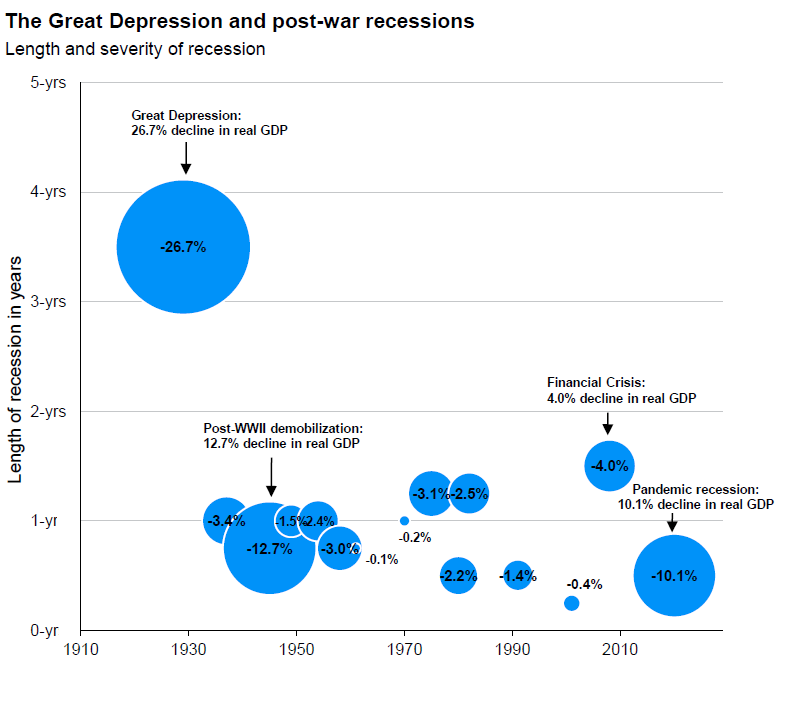
Source: BEA, NBER, J.P. Morgan Asset Management
Further, with so many focused on a potential recession, we think there remains a not insignificant chance that no recession occurs in 2023. Inflation has been declining for many months, and the Federal Reserve is expected to reduce interest rate hikes to .25% and possibly halt hikes altogether before mid-year – depending on incoming economic data. So far the economy has absorbed the higher interest rate environment well. While this doesn’t guarantee smooth sailing from here, higher interest rates should be good for savers and the economy longer-term relative to the near zero interest rate policy of the last decade.
Where We Are Investing Now
While stocks experienced a “run of the mill” bear market in 2022, bonds notched their worst year in modern history. The 10 year returns for the aggregate domestic bond market have now annualized at around 1% per year over the last 10 years. For many years we have maintained a high allocation to unconstrained fixed income holdings as a hedge against interest rate risk. These holdings performed significantly better than the broad bond market in 2022, but we have begun to reduce these positions in favor of now better yielding opportunities in traditional investment grade bonds and bond funds. Yields on investment grade government and corporate bonds are all significantly improved from the levels of a year ago.
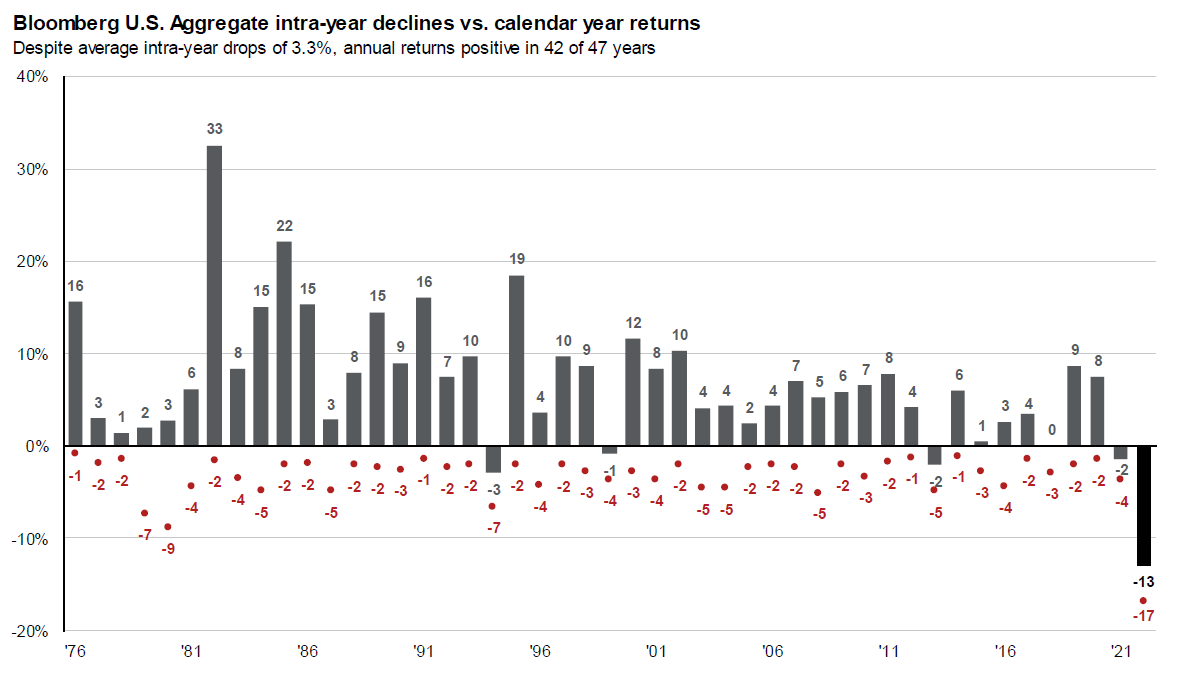
Source: Bloomberg, FactSet, J.P. Morgan Asset Management
In stocks, we continue to tilt portfolios to more value oriented sectors of the stock market and have recently increased exposure to mid-cap stocks. Mid and small-cap stocks continue to be priced at historically inexpensive levels relative to larger companies; and value oriented stocks continue to offer better prospects than their growth peers. However, exposure to growth oriented companies is still a core component of most clients’ equity exposure.
The strategy updates that we discuss in this letter are specific to our firm’s diversified asset allocation strategies and may not affect all clients. Please contact us if you want to discuss your specific portfolio strategy.
Should you have any questions regarding your investment account(s) and personal financial plans, or if there have been any recent changes to your investment and/or retirement objectives, please do not hesitate to contact our office to speak with one of us at your convenience. We can also provide you with a current copy of our SEC Form ADV Part 2, at your request.
As always, we thank you for entrusting AMM to help you achieve your investment and retirement objectives.
Your Portfolio Management Team



